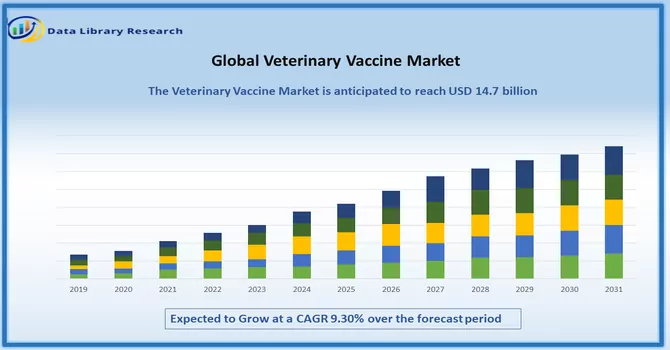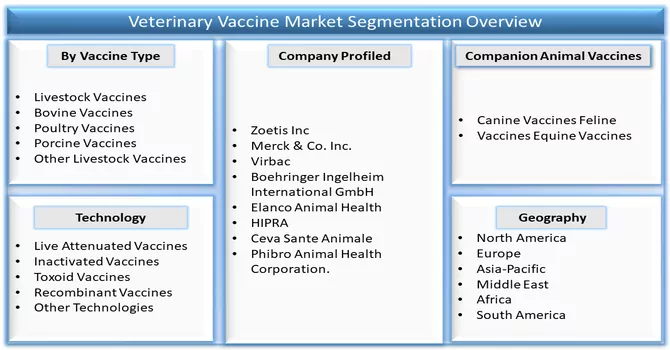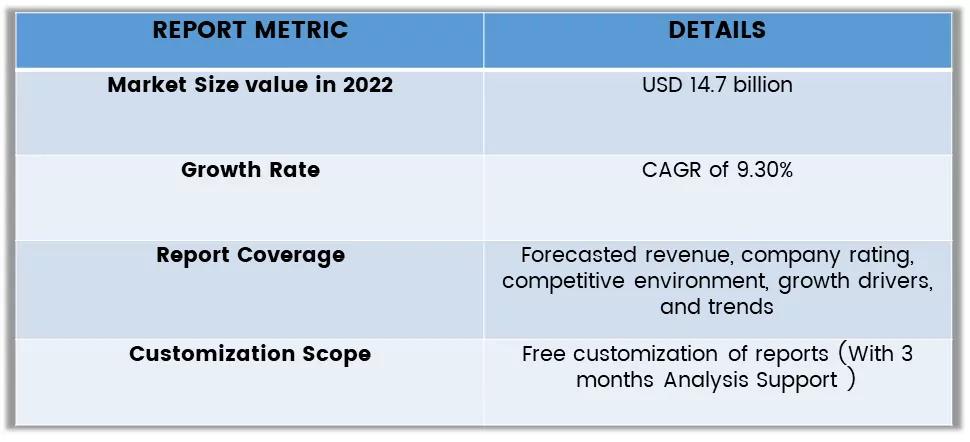The global veterinary vaccines market size was valued at USD 14.7 billion in 2022 and is expected to increase to 27.4 billion by 2030 at a compound annual growth rate (CAGR) of 9.30% from 2023 to 2030.

Get Complete Analysis Of The Report - Download Free Sample PDF
Animal vaccination is the immunization of a domestic, livestock, or wild animal. The practice is connected to veterinary medicine.
The increasing outbreaks of cattle disease and the ever-expanding livestock population are the prime factors for the wide acceptance of ruminants especially cattle vaccines globally. Animals serve as a vital source of meat, protein, food, milk, and other commercial products such as wool and leather. Most used animal vaccines comprise rabies vaccines, equine influenza virus vaccines, and foot and mouth diseases vaccines, which prevent the transmission of infectious agents by mimicking naturally acquired immunity.
The recent developments in veterinary vaccines like nucleic acid vaccines, mRNA vaccines, vector vaccines, and biomaterial-based vaccines are recent trends in the revolutionization of vaccines based on their potential to address issues of existing technology. Also, future trends for veterinary vaccines must include mRNA vaccines. Vaccines consisting of mRNA that encodes a protective antigen from the pathogen of interest offer a new and exciting approach to the development of veterinary immunoprophylaxis.
The Veterinary Vaccine Market is Segmented
By Vaccine Type :
Companion Animal Vaccines :
Technology :
Geography :
The market report also covers the estimated market sizes and trends for 17 different countries across major regions, globally. The report offers the value (in USD million) for the above segments.

For Detailed Market Segmentation - Download Free Sample PDF
Market Driver:
Increasing Incidence of Livestock Diseases and Increasing Pet Adoption Globally
An increase in pet adoption during recent years worldwide is boosting companion animal vaccine growth during the forecast period. For instance, according to the People's Dispensary for Sick Animals (PDSA), Animal Wellbeing June 2021 report, 2 million people in the United Kingdom adopted a pet in 2021. Out of these pets, 10% were dogs, 8% were cats and 13% were rabbits. Such a high rate of pet adoption in the country has increased the focus on the healthcare of animals, thus increasing the demand for appropriate pet vaccines, thereby boosting the market.
Initiatives by Government Agencies, Animal Associations, and Leading Players
The strategic initiatives by the government worldwide for the vaccination of animals are expected to propel market growth. For instance, in June 2022, Indonesia launched a nationwide livestock vaccination program as the number of cattle infected with foot and mouth disease surged to more than 151 thousand. These initiatives create opportunities for market players to develop innovative and effective veterinary vaccines, thereby propelling market growth.
Market Restraints:
High Storage Costs for Vaccines and Shortage of Veterinarians and Skilled Farm Workers
The high storage costs for vaccines and the shortage of veterinarians and skilled farm workers are estimated to restrain the market growth. For instance, in February 2023, as per ManyPets.Com reported the cost of annual dog booster vaccinations in Britain. In Britain, we found that the average cost for an annual booster for dogs is EUR 47. Similarly, data published by MSD reported that the average cost for cattle vaccines is EUR 40.
Furthermore, Cairn Technology in May 2023, reported that the UK’s veterinary workforce relies on overseas registrants to meet required levels, but the Royal College of Veterinary Surgeons (RCVS) figures suggest that the annual number of registrants coming to work as vets in the UK fell by 68%, from 1,132 in 2019 to 365 in 2021. Thus, the lack of skilled veterinarians may slow down the growth of the studied market.
The COVID-19 pandemic impacted the growth of the global veterinary vaccines market. For instance, a study published in the article titled, “The Promises of Speeding Up: Changes in Requirements for Animal Studies and Alternatives during COVID-19 Vaccine Approval–A Case Study” in July 2022 reported that during March 2020, the entire pharmaceutical industry’s focus was on the development of animal vaccine and the slow approval of animal vaccine impacted the growth of the studied market. However, with the subsequent decrease in COVID-19 cases and the resumption of various paused animal vaccine studies, the market is expected to witness significant growth over the forecast period.
Segmental Analysis Veterinary Vaccine Market
Poultry Vaccines by Vaccine Type is Expected to Witness Significant Growth Over the Forecast Period.
Poultry are domesticated birds kept by humans to harvest useful animal products such as meat, eggs, or feathers, and the practice of raising poultry is known as poultry farming. The vaccines that are designed to protect these animals from harmful infections and diseases are called poultry vaccines.
The launch of new poultry vaccines is expected to drive the growth of the studied market. For instance, in January 2023, Boehringer Ingelheim’s U.S. Animal Health Business launched the VAXXITEK HVT+IBD+ND vaccine that provides a strong immune foundation and optimized protection against Marek’s Disease, Infectious Bursal Disease (classic and variant types), and Newcastle Disease. VAXXITEK HVT+IBD+ND provides producers flexibility and expected protection against three diseases with one product.
Recombinant Animal Vaccines Segment is Expected to Witness Significant Growth over the Forecast Period
The recombinant veterinary vaccine involves inserting the DNA encoding an antigen (such as a bacterial surface protein) that stimulates an immune response into bacterial or mammalian cells, expressing the antigen in these cells, and then purifying it from them. include proteins, peptides, and DNA. Recombinant vaccines in veterinary medicine include those protecting against Lyme disease, pseudorabies, rabies, canine distemper, Newcastle disease, and a strain of avian influenza. Furthermore, the launch of new vaccines is fueling the growth of this segment. For instance, in July 2023, Dyadic International, Inc. reported the growing demand for global protein bioproduction and unmet clinical needs for effective, affordable, and accessible biopharmaceutical products for human and animal health, today provided an update regarding its Phase 1 Clinical Trial for its DYAI-100 COVID-19 recombinant protein receptor binding domain (RBD) booster vaccine candidate. Thus, propelling the growth of this segment.
North America is Expected to Dominate the Market Over the Forecast Period.
The North American region is expected to witness significant growth over the forecast period, owing to the growing consumption of meat and eggs. Also, some of the well-established major players are present in the region, which is expected to dominate the growth of the studied market. For instance, in 2021, Merck Animal Health joined forces with Automazioni VX, Inc. The main goal of this collaboration was to introduce Innoject Pro, a new subcutaneous chick vaccination technology. The technology will be combined with Merck Animal Health's Innovax vaccines to protect poultry against infectious diseases.
Moreover, the high incidence of canine disorders in North American countries is increasing the demand for veterinary vaccines, thereby contributing to the studied market growth. For instance, an article published by the National Canter for Biotechnology Information in June 2022, reported that in the past decade, there has been an apparent increased frequency and widened distribution of canine leptospirosis in Canada. The article reported that a cross-sectional study analyzed data obtained from IDEXX Laboratories, Inc. on 10,437 positive canine Leptospira PCR tests (blood and/or urine) submitted by Canada-based veterinarians (July 2009 to May 2018). Thus, such instances are contributing to the studied market growth.

Get Complete Analysis Of The Report - Download Free Sample PDF
Competitive Landscape of Veterinary Vaccine Market
The veterinary vaccines market is fairly competitive and consists of several major players. Most of these major players enjoy a global presence, and they are facing intense competition in emerging economies. Emerging countries are becoming hotspots for significant competition due to the rapidly expanding market, fueled by rising concerns over food safety and the increasing adoption of companion animals. Some market players are:-
Key Players :
Recent Development :
1) In September 2022, Merck Animal Health launched NobivacIntra-Trac Oral BbPi for the dual prevention of two major canine respiratory pathogens.
2) In August 2022, the Indian Council of Agricultural Research, ICAR-National Research Centre on Equines (ICAR-NRCE), Hisar (Haryana), in collaboration with ICAR-Indian Veterinary Research Institute (IVRI), Uttar Pradesh developed a homologous live-attenuated Lumpy Skin Disease vaccine named Lumpi-ProVacInd.
Q1. How big is the Veterinary Vaccine Market?
The global Veterinary Vaccine market size was valued at USD 14.7 billion in 2022 and is expected to increase to 27.4 billion by 2030 at a compound annual growth rate (CAGR) of 9.30% from 2023 to 2030.
Q2. What is the Growth Rate of the Veterinary Vaccine Market?
Veterinary Vaccine Market expected to increase at a compound annual growth rate (CAGR) of 9.30%
Q3. What segments are covered in the Veterinary Vaccine Market Report?
Veterinary Vaccine Market Report has covered segmentation like - By Vaccine Type, Companion Animal Vaccines, Technology and Geography
Q4. What are the latest developments in the Veterinary Vaccine Market?
The recent developments in veterinary vaccines like nucleic acid vaccines, mRNA vaccines, vector vaccines, and biomaterial-based vaccines are recent trends in the revolutionization of vaccines based on their potential to address issues of existing technology.
Data Library Research are conducted by industry experts who offer insight on industry structure, market segmentations technology assessment and competitive landscape (CL), and penetration, as well as on emerging trends. Their analysis is based on primary interviews (~ 80%) and secondary research (~ 20%) as well as years of professional expertise in their respective industries. Adding to this, by analysing historical trends and current market positions, our analysts predict where the market will be headed for the next five years. Furthermore, the varying trends of segment & categories geographically presented are also studied and the estimated based on the primary & secondary research.
In this particular report from the supply side Data Library Research has conducted primary surveys (interviews) with the key level executives (VP, CEO’s, Marketing Director, Business Development Manager and SOFT) of the companies that active & prominent as well as the midsized organization
FIGURE 1: DLR RESEARH PROCESS

Extensive primary research was conducted to gain a deeper insight of the market and industry performance. The analysis is based on both primary and secondary research as well as years of professional expertise in the respective industries.
In addition to analysing current and historical trends, our analysts predict where the market is headed over the next five years.
It varies by segment for these categories geographically presented in the list of market tables. Speaking about this particular report we have conducted primary surveys (interviews) with the key level executives (VP, CEO’s, Marketing Director, Business Development Manager and many more) of the major players active in the market.
Secondary ResearchSecondary research was mainly used to collect and identify information useful for the extensive, technical, market-oriented, and Friend’s study of the Global Extra Neutral Alcohol. It was also used to obtain key information about major players, market classification and segmentation according to the industry trends, geographical markets, and developments related to the market and technology perspectives. For this study, analysts have gathered information from various credible sources, such as annual reports, sec filings, journals, white papers, SOFT presentations, and company web sites.
Market Size EstimationBoth, top-down and bottom-up approaches were used to estimate and validate the size of the Global market and to estimate the size of various other dependent submarkets in the overall Extra Neutral Alcohol. The key players in the market were identified through secondary research and their market contributions in the respective geographies were determined through primary and secondary research.
Forecast Model
